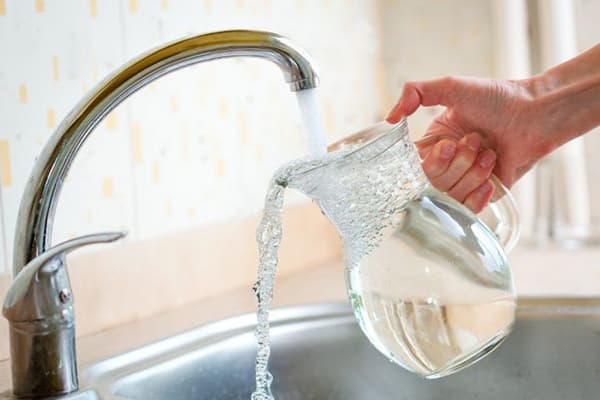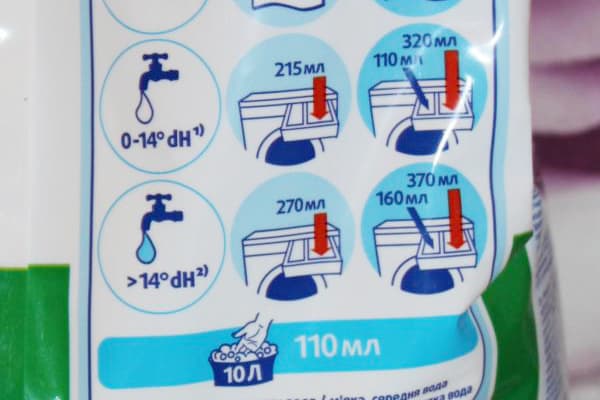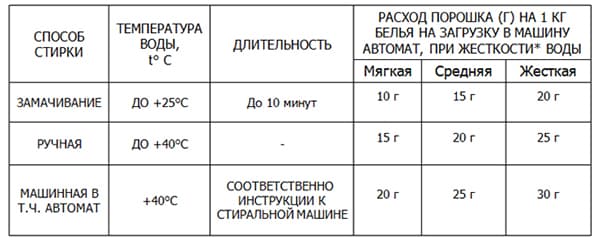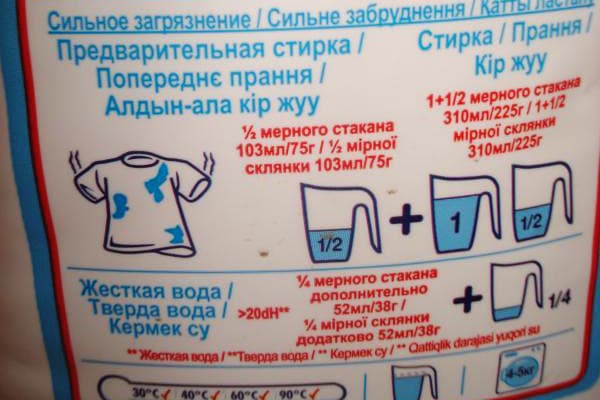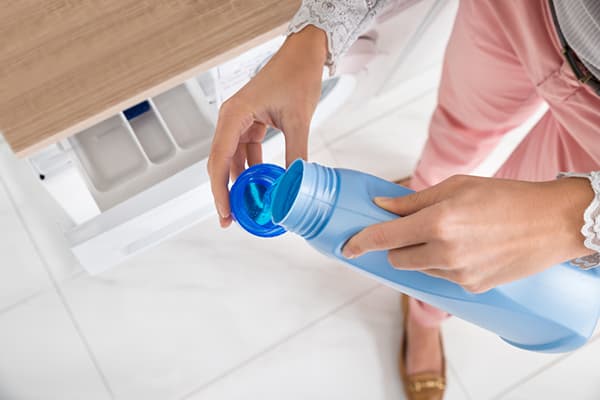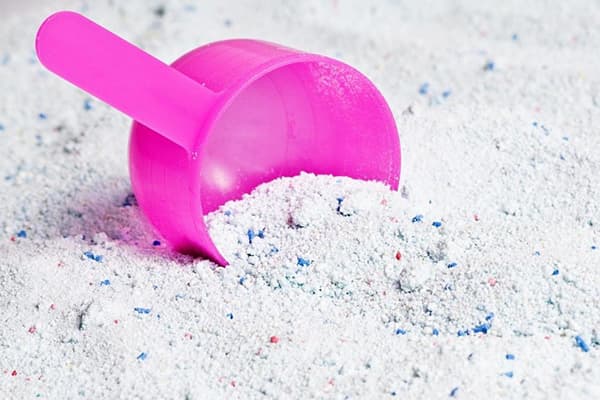The more washing powder you add when washing, the better?
Every housewife at least once in her life has encountered a situation where the automatic washing machine failed to cope with its intended task and the item remained dirty after washing. This begs a lot of questions, and one of the most important ones is whether washing powder is to blame for this? Perhaps we should have added more of it? There is definitely a rational grain in such a conclusion. Indeed, in a higher dose of powder the surfactant content is higher. This means that the removal of contaminants will occur more intensively. Unfortunately, this is not always the case. The rule “the more powder, the better” only applies in 2 cases, and we will talk in detail about each of them.
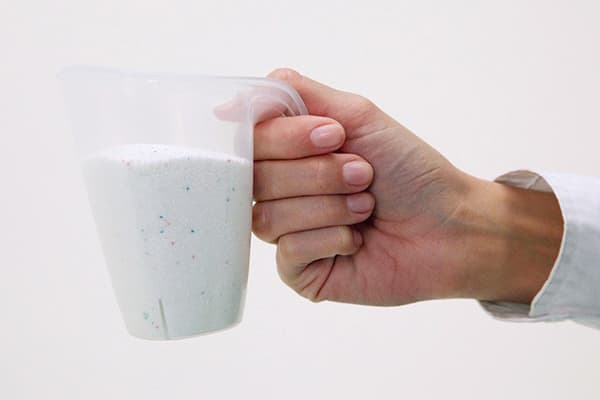
When should you add more powder?
Information on the dosage of washing powder for an automatic washing machine can always be found on the packaging. The correct amount of product may vary depending on the brand and the degree of concentration (concentrates are used in much smaller volumes). The average dosage of regular laundry detergent for 1 kg of dry laundry is 25 grams. That is, in order to wash 4.5–5 kg of clothes, you need to put approximately 125 g of washing powder in a special compartment.
But there are situations when you need to pour almost 2 times more detergent.
The tap water is too hard
Powder consumption when washing in a washing machine depends on many factors. One of the most important is the hardness of tap water.In soft water, things are washed better, even if you use a minimum of powder, this is a fact. Hard ones contain a lot of calcium and magnesium salts, which prevent laundry from being cleaned. Soap substances react with salts, dissolve poorly, and eat into the fabric.
You can determine the hardness of water in a house or apartment by the formation of scale in the kettle. If plaque forms frequently and in large quantities, it means that the water contains a lot of salts. For an accurate result, you should use test strips for aquariums. Water is considered hard at a value of 10°F and above (a unit of measurement of hardness in Russia), or 13–22° degrees dH.
How much powder should I pour if the water is hard? Sometimes the dosage of detergent at a high dH level is indicated by the manufacturer himself in a separate column.
If this parameter is not indicated on the packaging, it is correct to refer to the following table:
That is, for 5 kg of laundry you need to use 150 g of powder.
Water with a high salt content not only prevents laundry from being cleaned, but also harms the washing machine, leaving limescale on its parts. Therefore, instead of increasing the dosage of powder, it is better to use water softeners (Calgon, soda ash).
Things are very dirty
The second important factor that affects the effectiveness of a detergent is the amount of dirt. Neutralizing them takes more surfactants and requires more time (a full machine wash cycle).
The manufacturer often indicates how much powder to pour for very dirty items:
If the value is not specified, add 10 g of powder for every 1 kg of dry laundry. That is, to wash 5 kg of very dirty clothes in hard water, you will need to put 200 g of washing powder in a special compartment.
How to improve the quality of washing?
The idea of adding more washing powder when washing most often arises when the clothes are not washed, there are still stains and yellowed areas on them. This problem must be dealt with with special means or by soaking.
- Soaking and washing. Heavily dirty laundry should be soaked in warm soapy water for about 30 minutes before washing. This will soften stubborn stains. Dried solid contaminants are removed mechanically. Hand washing is often much more effective than machine washing.
- Stain removers and bleaches. Even the most effective washing powder cannot cope with removing difficult stains, such as oil, wine, or dandelion juice. Here you need to connect special stain removers and bleaches. For example, ACE Oxi Magic, “Sarma Active 5 in 1”, “Bleach Bos”, Amway PreWash Spray, Vanish OXI Action.
- Program. Washing powders work best at high temperatures – 60°C and 90°C. Therefore, unless the fabric is delicate, you should choose a higher temperature and a full wash cycle.
Modern technologies also help improve the quality of washing. For example, machines with the EcoBubble function first mix detergent with water and air, and then wash clothes with homogeneous foam.
Negative consequences of exceeding the dosage of powder
“More” is not synonymous with “better.” In everything you need to observe reasonable measures. By significantly exceeding the dosage of washing powder specified in the instructions, the housewife runs the risk of encountering negative consequences:
- Large amount of foam. Defoamers are added to the powder marked “Automatic”, since excessive foam is harmful for washing machines.It can penetrate outside the drum, damage electrical equipment, and cause a short circuit.
- White stains on clothes. The more powder, the more difficult it is to rinse out. After washing, white spots and streaks will remain on things. They are especially noticeable on dark-colored clothing.
- Accumulation of powder in the container, clogging of the compartment. Many washing machine models take as much powder as you need. Excess product remains in the container, clumps and can cause a clog.
- Unpleasant smell from the machine and from clothes. Proper washing should end with rinsing in clean water. If there is too much detergent, it is not rinsed out and accumulates inside, and gradually a plaque with an unpleasant odor forms on the parts.
Exceeding the dosage of washing gels is not as dangerous as powder detergents. However, even here it is important to observe reasonable measures. For dosing, use a measuring cap marked in ml. On average, 1 cap of gel is consumed per 1 kg of laundry, or 50–60 ml (if it is not a concentrate).
When using washing powder for cars, few people think about how much they need to put in. Many housewives pour it into the compartment “by eye” - and make a mistake. It is important to take into account the recommendations of the product manufacturer, and not only that. The amount of powder directly depends on the load level of the washing machine, the amount of dirt, and water hardness. Sometimes it is advisable to add stain remover or bleach. Use the right approach to washing, and then your clothes will always be sparkling clean, and your equipment will last for many years!
